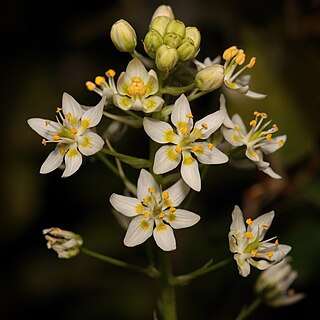
Melanthiaceae, also called the bunchflower family, is a family of flowering herbaceous perennial plants native to the Northern Hemisphere. Along with many other lilioid monocots, early authors considered members of this family to belong to the family Liliaceae, in part because both their sepals and petals closely resemble each other and are often large and showy like those of lilies, while some more recent taxonomists have placed them in a family Trilliaceae. The most authoritative modern treatment, however, the APG III system of 2009, places the family in the order Liliales, in the clade monocots. Circumscribed in this way, the family includes up to 17 genera.

Toxicoscordion fremontii, known as the common star lily or Frémont's deathcamas or star zigadene, is an attractive wildflower found on grassy or woody slopes, or rocky outcrops, in many lower-lying regions of California, southwestern Oregon, and northern Baja California.

Amianthium is a North American genus of perennial plants growing from bulbs. It contains the single known species Amianthium muscitoxicum, known in English as fly poison from a literal translation of the Latin epithet muscitoxicum, and is noted for its pretty flowers and its toxic alkaloid content. While all parts of the plant are poisonous, the bulb is particularly toxic. The scientific epithet was given to it by Thomas Walter when he published his Flora Caroliniana in 1788.

Toxicoscordion venenosum, with the common names death camas and meadow death camas, is a species of flowering plant in the genus Toxicoscordion, of the Melanthiaceae family. It is native to western North America from New Mexico to Saskatchewan and west to the Pacific Ocean.
Deathcamas or death camas refers to several species of flowering plant in the tribe Melanthieae. The name alludes to the great similarity of appearance between these toxic plants, which were formerly classified together in the genus Zigadenus, and the edible camases (Camassia), with which they also often share habitat. Other common names for these plants include deadly zigadene, hog potato and mystery-grass.

Toxicoscordion micranthum, the smallflower deathcamas, is a flowering plant in the genus Toxicoscordion. It is native to Oregon and California, primarily in the Coast Ranges from Douglas County to Napa and Sonoma Counties, with isolated populations in Lassen, Plumas, Santa Clara, and San Benito Counties. It is a member of the serpentine soils flora.

Schoenocaulon is a North American genus of perennial herbaceous flowering plants, ranging from the southern United States to Peru. It is a member of the Melanthiaceae, according to the APG III classification system, and is placed in the tribe Melanthieae. Unlike other genera in the tribe, the flowers are arranged in a spike; depending on the species the flower stalks for each flower are either very short or completely absent. Feathershank is a common name, the medicinally used S. officinale is called Sabadilla.

Melanthium is a genus of herbaceous perennial plants native to North America. They are closely related to Veratrum, and in fact are included in that genus by some authors. The distinction between Melanthium and Veratrum is based on various morphological traits, but it is not yet clear where the line is best drawn.

Anticlea is a genus of flowering plants in the family Melanthiaceae, tribe Melanthieae. Molecular phylogenetic studies in the 21st century have resulted in number of changes to placements within this tribe. Anticlea was long submerged into the genus Zigadenus; however its separate position has been confirmed. Some species were also moved from Stenanthium into Anticlea. Members of Anticlea may also be distinguished from other members of the former genus Zigadenus, the deathcamases, by the presence of narrow tepals with a single, conspicuous, bilobed gland. It also has a wider distribution, occurring in Asia and much of North and Central America, ranging south to Guatemala.

Toxicoscordion is a genus of flowering plants in the family Melanthiaceae, tribe Melanthieae, first described as a genus in 1903. The genus is mainly distributed in the midwestern United States and western North America, with some species in western Canada and northern Mexico.

Stenanthium is a North American genus of flowering plants in the tribe Melanthieae of the family Melanthiaceae.

Zigadenus is a genus of flowering plants now containing only one species, Zigadenus glaberrimus, the sandbog death camas, found in the southeastern United States from Mississippi to Virginia. Around 20 species were formerly included in the genus, but have now been moved to other genera.
Toxicoscordion brevibracteatum is a species of flowering plant known by the common name desert deathcamas. It is native to Baja California, Sonora, and California, where it grows in sandy desert habitat among creosote and Joshua trees.

Toxicoscordion paniculatum is a species of flowering plant known by the common names foothill deathcamas, panicled death-camas, and sand-corn. It is widely distributed across much of the western United States, especially in the mountains and deserts of the Great Basin region west of the Rocky Mountains. It grows in many types of habitat, including sagebrush plateau, grasslands, forests, and woodlands, etc.

Veratrum hybridum is a species of flowering plant in the Melanthiaceae known by the common names slender bunchflower and crisped bunchflower. Many publications use the synonyms Melanthium latifolium and Veratrum latifolium, but the "hybridum" epithet is 9 years older than the "latifolium," so Veratrum hybridum is now the accepted name.

Toxicoscordion nuttallii is a species of poisonous plant native to the south-central part of the United States.

Stenanthium densum is a poisonous but spectacular monocot wildflower native to pine barrens of the eastern United States. It is known variously as Osceola's plume, crowpoison, or black snakeroot. Stenanthium leimanthoides is either treated as a synonym of this species or as a separate species. It is native to the southernmost Gulf Coast, from eastern Louisiana east, down through most of Florida, and to the easternmost Atlantic Coast north to Rhode Island, seldom far from the coast.
Melanthium woodii, common names Wood's bunchflower or Ozark bunch-flower, is a species formerly known as Veratrum woodii. It is native to the central and southeastern parts of the United States, from Arkansas, Florida, Georgia, Illinois, Indiana, Iowa, Kentucky, Missouri, North Carolina, Ohio, Oklahoma and Tennessee. It can be found in forested areas at elevations less than 800 m.
Toxicoscordion fontanum,, common name small-flower death camas, is a rare plant species known only from serpentine marshes in California. It is found primarily in the Coast Ranges from Mendocino County to San Luis Obispo County, with an additional report of an isolated population in the Sierra Nevada foothills in Kern County east of Bakersfield.

Zygacine is a steroidal alkaloid of the genera Toxicoscordion, Zigadenus, Stenanthium and Anticlea of the family Melanthiaceae. These plants are commonly known and generally referred to as death camas. Death camas is prevalent throughout North America and is frequently the source of poisoning for outdoor enthusiasts and livestock due to its resemblance to other edible plants such as the wild onion. Despite this resemblance, the death camas plant lacks the distinct onion odor and is bitter to taste.



















